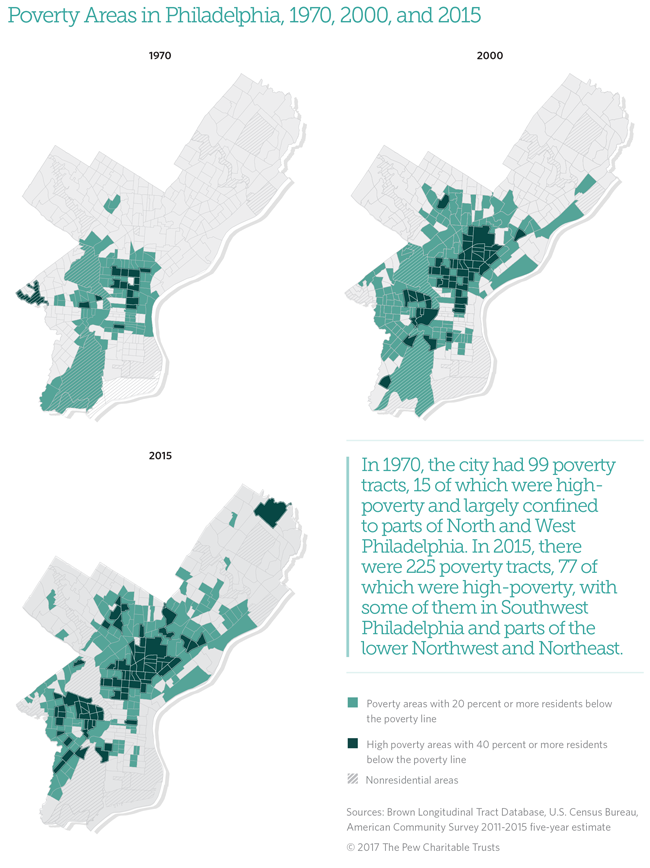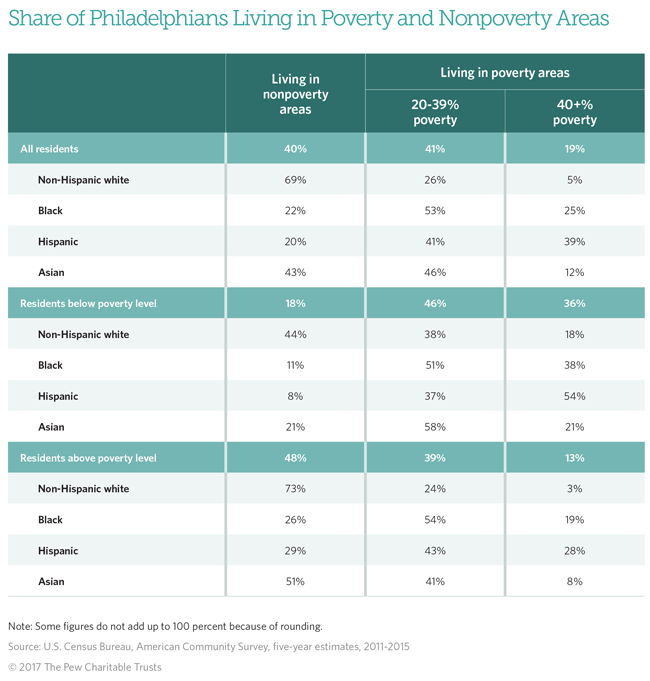Where Do Philadelphia’s Poor Live?
Once highly concentrated, poverty is now spread across a wide swath of the city
Decades ago, poverty in Philadelphia was concentrated in specific neighborhoods, most of them within the same general vicinity. Today, it is much more dispersed. The U.S. Census Bureau considers any tract with a poverty rate of 20 percent or higher to be a poverty area. Fifty-nine percent of Philadelphia’s census tracts fall into this category.
In 1970, the city had 99 poverty tracts, 15 of which were high-poverty, defined as having a poverty rate of 40 percent or more, and largely confined to parts of North and West Philadelphia. In 2015, there were 225 poverty tracts, 77 of which were high-poverty, with some in Southwest Philadelphia and parts of the lower Northwest and Northeast.
Poverty has become a defining characteristic of a large part of the city, and much of this change took place before 2000. Yet the spread of poverty from compact clusters to larger dispersed areas isn’t unique to Philadelphia; it’s a common trend among the cities studied in The Pew Charitable Trusts’ November 2017 report “Philadelphia’s Poor: Who They Are, Where They Live, and How That Has Changed.”
Sixty percent of all Philadelphians and 82 percent of the poor live in poverty areas. Forty-six percent of the poor live in areas where the poverty rate is 20 to 39 percent, and 36 percent live in tracts where the rate is 40 percent or higher. This is a stark change from 1970, when 25 percent of all Philadelphians and 53 percent of the poor lived in such areas.
Eighty-nine percent of the city’s poor blacks live in census tracts where the poverty rate is 20 percent or higher, along with 73 percent of black residents with income above the poverty line. Twenty-five percent of all black residents live in high-poverty areas, as do 38 percent of the black poor.
Ninety-one percent of the city’s poor Hispanic residents and 71 percent of those above the poverty line live in poverty areas. Thirty-nine percent of all Hispanics live in high-poverty areas, as do 54 percent of the Hispanic poor.
Forty-three percent of Asians in the city live in census tracts where the poverty rate is below 20 percent. This rate is slightly above the citywide average. Fifty-eight percent of poor Asians live in neighborhoods where the poverty rate is 20 to 39 percent, and the remainder are evenly split between high-poverty and low-poverty census tracts.
Meanwhile, 69 percent of non-Hispanic whites live in areas where the poverty rate is under 20 percent. Forty-four percent of poor whites live in nonpoverty areas, compared with 11 percent of blacks and 8 percent of Hispanics. Only 26 percent of nonpoor blacks and 29 percent of nonpoor Hispanics live in such areas.
For more stats and charts on the demographics of poverty in Philadelphia, including comparisons with other cities and regions, read our full report.
Larry Eichel directs The Pew Charitable Trusts’ Philadelphia research initiative. Octavia Howell is a researcher on the team and the study’s author.













